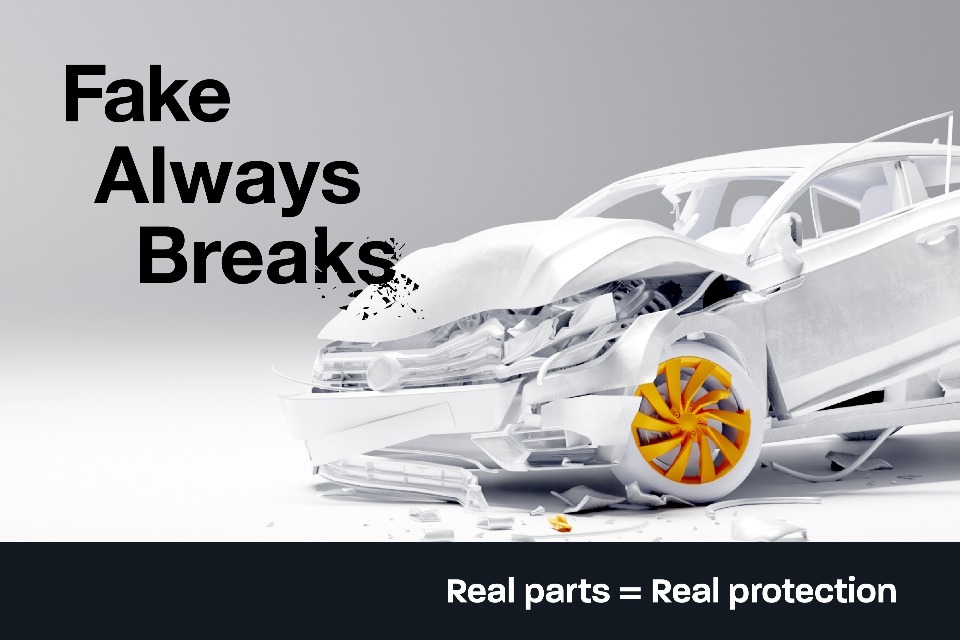Consumer guidance fake parts
Updated 18 October 2024

How to spot and avoid fake vehicle parts
Fake or sub-standard vehicle parts are often cheap-looking imitations, but it can sometimes be hard to tell the difference between a fake and genuine product. Such fake parts are usually made from inferior materials and are not safety-tested, increasing the risk of failure. This can have serious consequences to drivers, passengers, and other road users.
This guidance has been developed in partnership with the motor industry to help you avoid fake parts and report counterfeit sellers. It also provides tactics that you can employ to shop safely and ways to report counterfeit parts.
1. How to spot fake vehicle parts
It can be difficult for consumers to identify fake car parts, including commonly counterfeited components like brake pads and discs, spark plugs and filters. In this market where technology is constantly improving vehicles, particularly the safety aspects, criminals use advanced techniques to make the parts and packaging look genuine. Just looking at the part might not be enough to identify a fake part but remember, fake always breaks so be vigilant when replacing automative components.
2. Top tips to consider when buying vehicle parts
Price and seller
Be careful if a branded part is being sold for a cheaper price by a seller you don’t recognise, or even if it’s only marginally cheaper. If in doubt, research the seller regardless of shopping online or from the high street.
If the price is too good to be true, it probably is.
Value for money
You can choose between parts supplied by car manufacturers or by the aftermarket parts manufacturers. An aftermarket part is anything not supplied by a vehicle manufacturer under their own brand name. Both follow rigorous testing and have traceability, but fakes can be found in both categories. Use this guidance to help you before buying.
Sub-standard parts
Cheap parts aren’t always fake but can be just as dangerous. They can also void your vehicle warranty and/or insurance so do your research before purchasing parts.
Leave it to the experts: Don’t bring your own parts to the garage
To save money, some people purchase parts themselves and ask an independent garage to install them. However, fitting fake car parts can endanger both the driver and the garage team, it can also invalidate warranties and cause liabilities to garages. These parts are also unlikely to be covered by the garage under warranty if the part subsequently fails or for the supply of the replacement part or the labour costs to fit it.
For these reasons, many garages are cautious about installing customer-supplied parts. Trust experts such as those part of the Trust My Garage Scheme or a trusted local independent garage to source and fit your vehicle parts. Using such garages ensure the parts installed are genuine and safe, providing peace of mind for both you and the professionals working on your vehicle.
Technical standards
Genuine manufacturers provide proof that their parts meet the required standards with a certificate of Original Equipment (OE) matching quality.
If you buy a fake part, you won’t receive this so you won’t know what you are getting.
Specification
Even if two vehicles are of the same model and year, they might need slightly different parts.
Fake parts are likely to be ‘one size fits all’ which can be dangerous and damage your vehicle.
Tracking and recall
Vehicle manufacturers and legitimate suppliers can trace and replace faulty parts if there is a recall.
If you buy and fit a fake part in your vehicle, you could be at risk.
If you are still unsure, get advice from a Chartered Trading Standards Institute (CTSI)-approved garage, such as those in the Trust My Garage Network, a local independent garage you trust, authorised manufacturer dealership or parts distributor.
3. Buying parts online
Check the website: genuine websites let you report fake products
If you suspect a part you bought is fake, notify the website. It is worth noting that parts purchased outside Europe may not meet the “E” approvals for safety, function and emissions [footnote 1].
Get a refund:
If you used a credit or debit card to buy unknowingly fake parts, you can ask your bank for a refund via the ‘chargeback’ scheme.
Report on marketplaces:
Marketplaces such as eBay and Amazon have guides on how to report fakes and get a refund. Amazon customers should contact Customer Service for help and a refund.
4. Where to get further help
Manufacturer support: car manufacturers and aftermarket parts producers
Many companies provide tools to check the authenticity of their products. They also offer tips on spotting fakes and how to report them. Please refer to our business guidance on fake parts for more information car manufacturers and aftermarket parts producers.
Motorsports:
Motorsport UK provides advice on how to avoid fake motor sport equipment.
5. Where to report
Car manufacturers and aftermarket parts producers:
Please refer to our business guidance on fake parts for more information car manufacturers and aftermarket parts producers.
Law enforcement:
Report to Trading standards website using your postcode. Some local authorities may redirect you to the Citizens Advice reporting system.
If you wish to remain anonymous report to Crimestoppers online or call 0800 702 2020.
